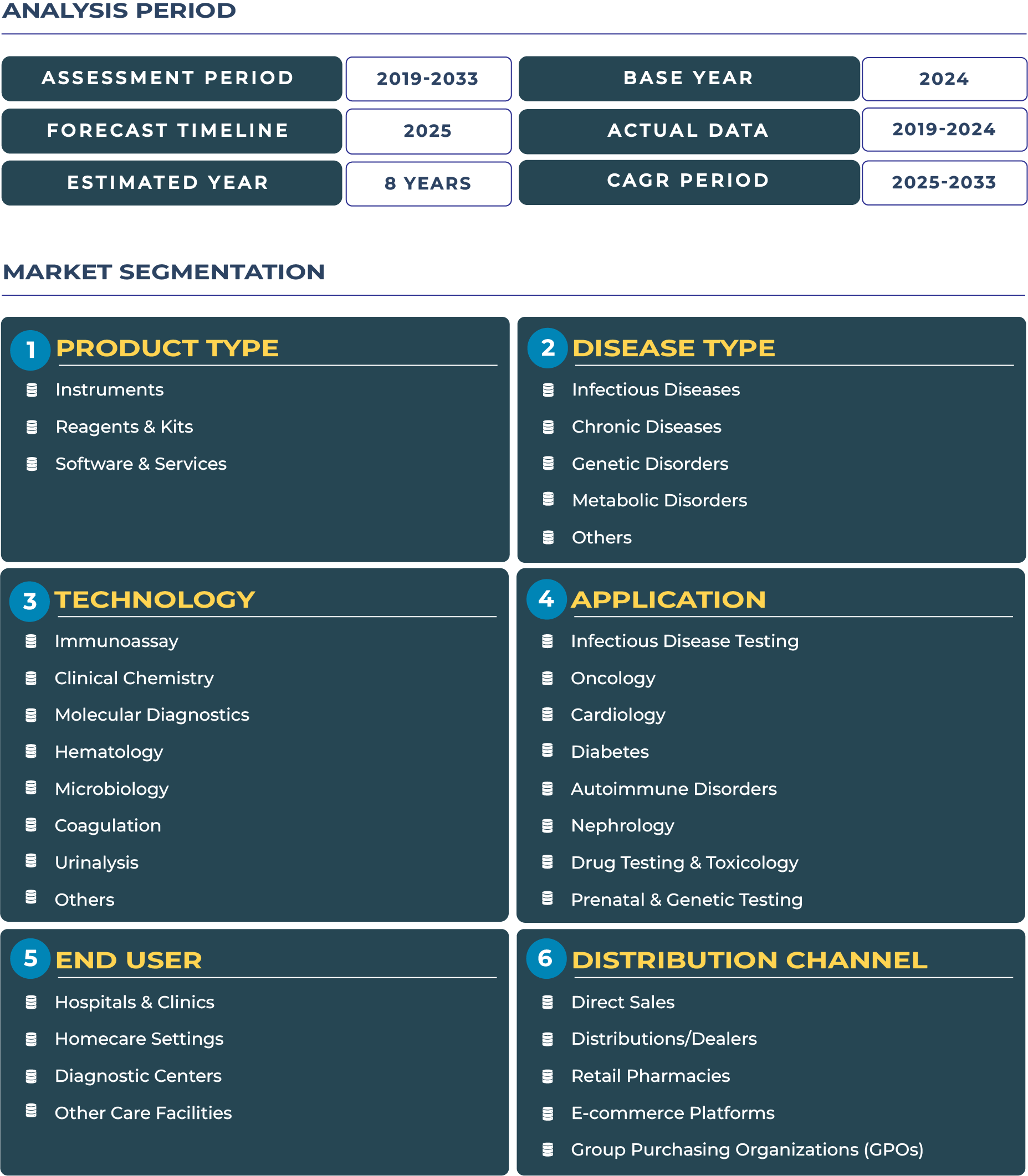Japan’s Diagnostic Maturity: Robotics Leadership, Aging Population & IVD Resilience
Japan stands at the frontier of advanced orthopedic robotics and precision healthcare, with one of the world’s oldest populations driving consistent demand for diagnostic services linked to surgical care and chronic disease management. The country pairs that demand with a highly developed manufacturing and R&D base, turning itself into both a high-consumption market and a platform for innovation. The Japanese in-vitro diagnostic (IVD) landscape is mature, yet still dynamic. Based on projections, the IVD market is expected to grow from approximately USD 4.84 billion in 2025 to USD 7.96 billion by 2033, at a CAGR of ~6.4%. This growth reflects structural upgrades, shifting disease burdens, and evolving hospital diagnostic frameworks.
Market Outlook: Saturated Base with Upside in Specialization and Service Depth
Japan IVD market is characterized by high baseline penetration; virtually all major hospitals and many clinics already deploy core diagnostic systems. As such, incremental growth must come through specialization, efficiency, and differentiated service. In the evolving environment, newer immunoassay panels, molecular diagnostics, companion diagnostics, and digital integration hold the growth potential. Hospitals in Tokyo, Osaka, and Nagoya are upgrading labs for next-gen testing, automation, and data analytics, while regional hospitals strive to keep pace. Despite demographic decline, diagnostic demand remains stable thanks to increased per capita testing, preventive programs, and greater health consciousness. However, expansion into underserved rural areas, integration with telehealth platforms, and bundled diagnostic-surgical workflows will be necessary to sustain growth beyond saturation.
Drivers & Restraints: High Utilization Meets Structural Barriers
High Procedure Volumes, Strong Reimbursement & Clinical Specialization Boost Uptake
Japan’s advanced hospital system routinely executes high volumes of orthopedic, cardiovascular, and oncologic surgeries. These procedural backbones generate steady demand for preoperative assessments, biomarker panels, and diagnostic monitoring cycles. The country’s reimbursement environment, backed by national health insurance and standardized diagnostic fee schedules, supports consistent utilization. Additionally, Japanese clinicians are highly specialized and data-driven, demanding high-quality assays, rapid turnaround, and traceability, driving adoption of premium diagnostics. This environment supports the uptake of refined reagents, automation, and integrated software services.
Market Saturation, Regulatory Stringency & Price Containment Limit Expansion
Despite favorable fundamentals, Japan IVD market faces significant headwinds. Saturation in major markets limits the addressable white space to incremental upgrades. Regulatory approvals (via the Ministry of Health, Labour and Welfare and the Pharmaceuticals and Medical Devices Agency) are strict, particularly for imported reagents or novel diagnostics. Price containment initiatives, via reimbursement caps and government-negotiated cost controls, apply pressure on margins. Further, as domestic manufacturers expand their cradle-to-grave IVD pipelines, they increasingly compete with global suppliers, especially in reagent-heavy business, making differentiation tougher.
Trends & Opportunities: Niche Growth, Outcome Focus & Service Bundles
Trend: ASC Growth, Longevity Focus & Conservative Care Adoption
Japan is witnessing growth in ambulatory surgical centers (ASCs), especially in urban hubs, creating demand for point-of-care diagnostics, rapid assays, and simplified workflows. Coupled with the aging population’s emphasis on longevity and quality of life, diagnostic tests that can monitor frailty markers, bone turnover, and metabolic decline are growing. Conservative medical management is more attractive in older patients, increasing demand for diagnostics in outpatient and monitoring settings, rather than only hospital-driven testing. Solutions that support longitudinal patient tracking and minimally invasive monitoring thus gain relevance.
Opportunity: Premium Implants, Diagnostic-Service Bundles & Long-Term Outcomes Evidence
High-end, long-life orthopedic implants tailored for Japan’s aging demographics can be complemented with bundled diagnostic services. Diagnostic companies can work with implant firms to provide biomarker monitoring, infection markers, and patient stratification as value-adds. Additionally, offering service contracts, digital follow-up applications, and long-term outcome studies strengthens the proposition. Premium differentiated implants that guarantee longer life expectancies align with Japan’s demand for durability, and diagnostics can underpin that narrative. Trials and evidence in Japanese cohorts will be key to procurement in hospital systems focused on longitudinal outcomes.
Competitive Landscape: Innovation Partnerships, Local Evidence & Longevity Positioning
The Japan IVD sector includes strong domestic and international players. A leading example is Sysmex Corporation, a Japanese company offering diagnostics instruments, reagents, and software globally. Sysmex recently completed the launch of a new instrument manufacturing facility in Nagano to bolster capacity and reliability of supply. The company continues to innovate in hematology, coagulation, and integrated laboratory information systems. Rival global firms such as Roche, Abbott, and Beckman Coulter operate through localized distribution and compliance strategies, often partnering on local clinical validation, KOL engagement, and long-term service agreements.
Strategic differentiation in Japan focuses on KOL-driven outcome studies, long-term reliability, extended warranties, and integrated diagnostic-surgical bundles. Some manufacturers form research alliances with academic hospitals in Tokyo or Kyoto to validate new assays in Japanese populations. Others emphasize instrumentation robustness and software upgrade flexibility to capture renewals in a mature installed base. Loyalty in Japan’s hospital systems is often built on long operational lifecycles and trusted service relationships; diagnosis providers that commit to lifecycle support can reinforce adoption.







